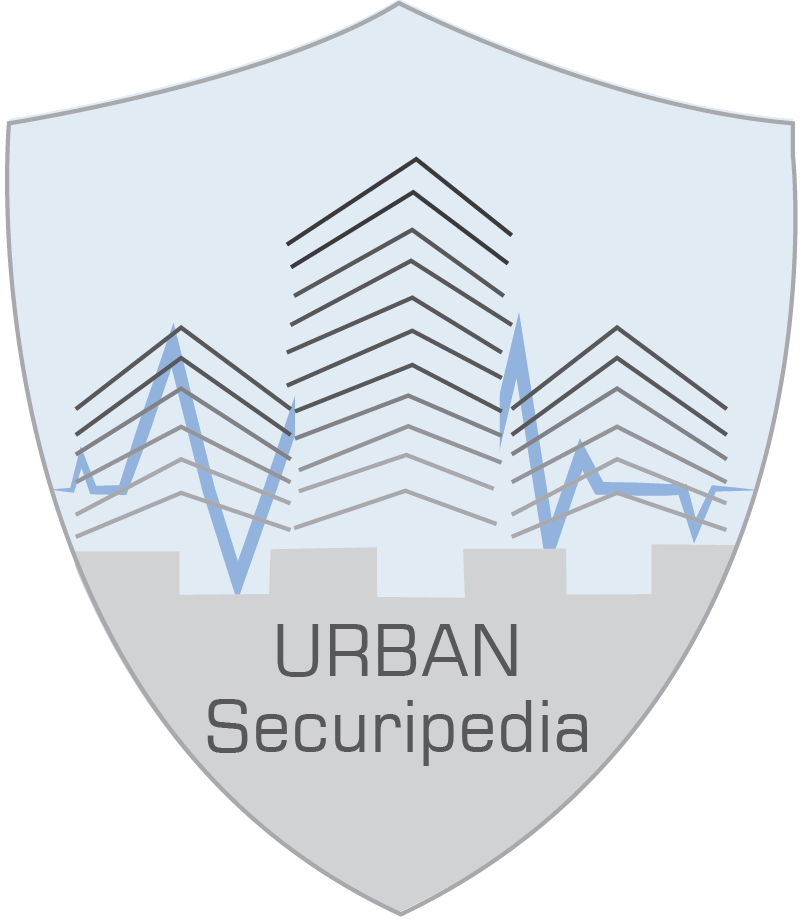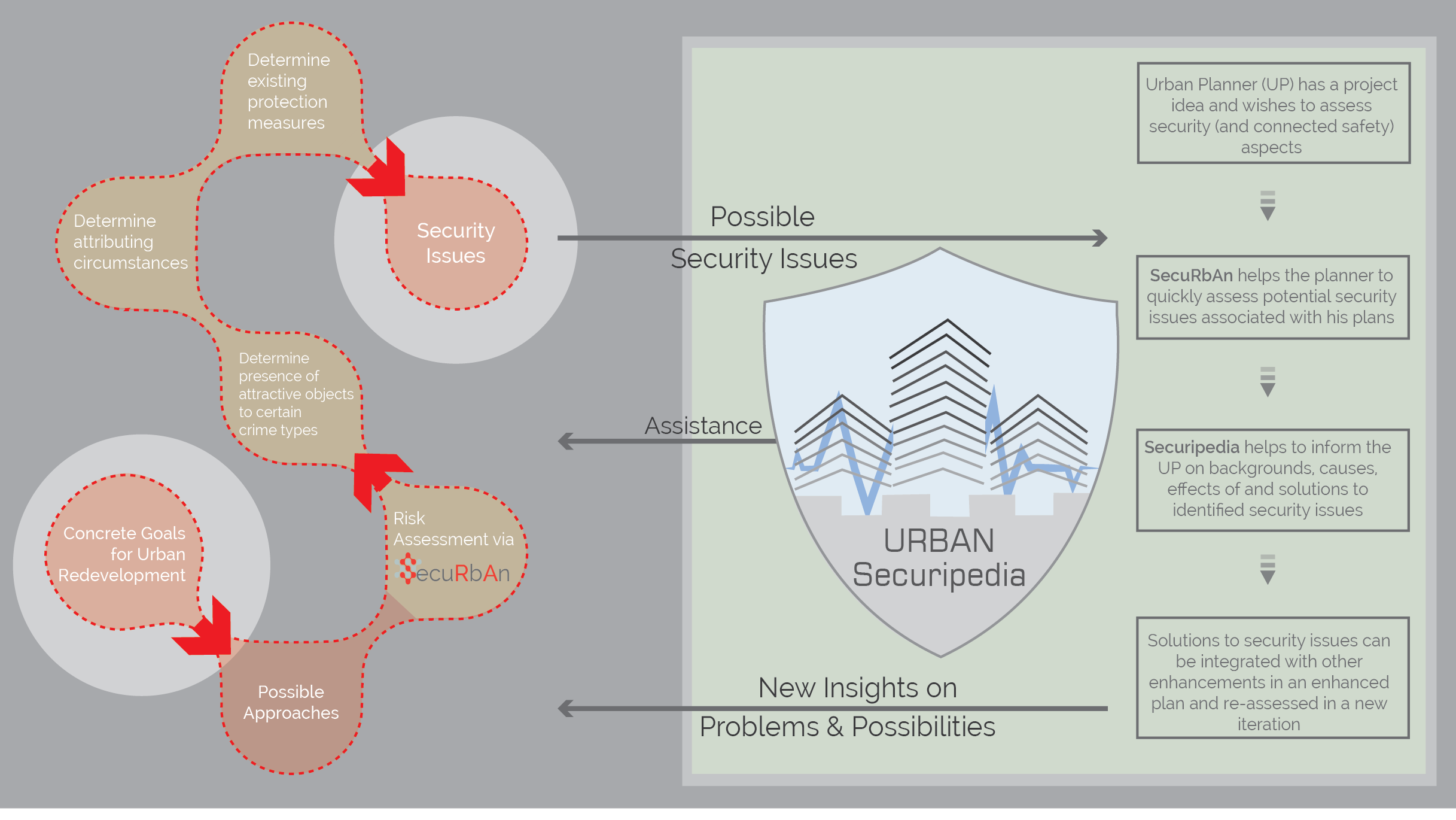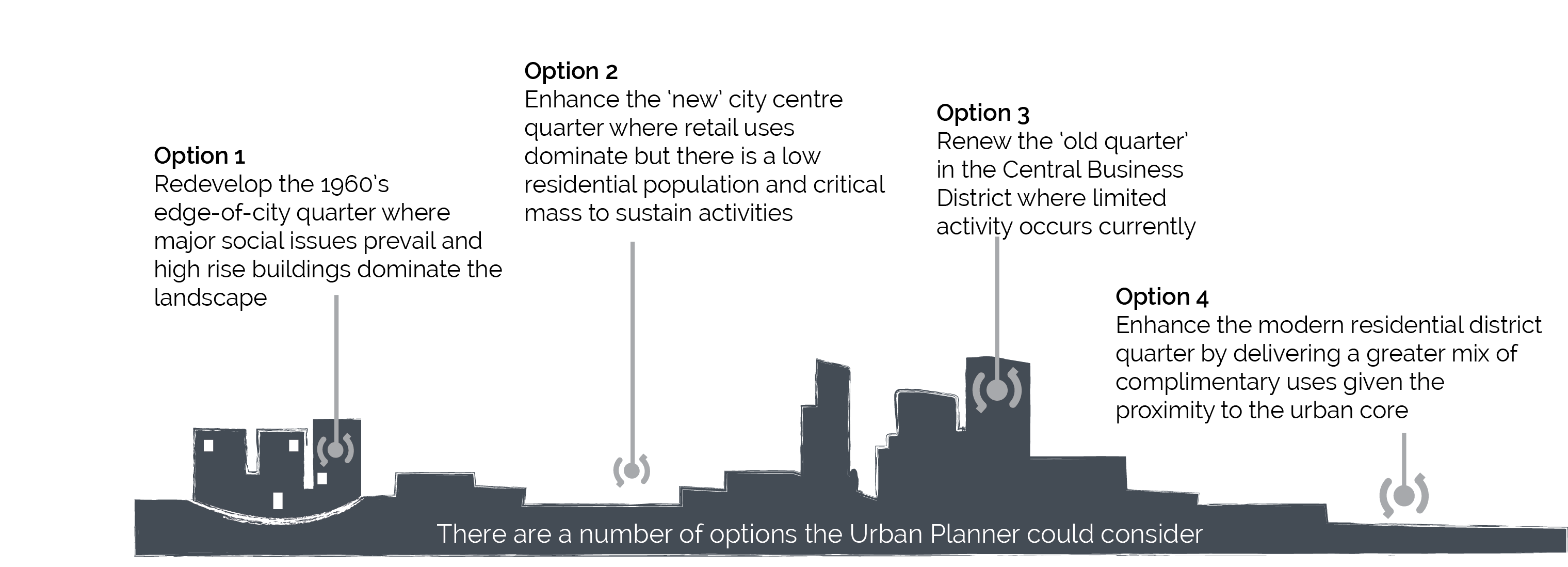When to use the Concept tool
This page explains the relationship between the two Concept level tool components:
- SecuRbAn Risk Assessment Tool;
- Urban Securipedia Knowledge Base.
The page is structured to provide a short description of the two tools, followed by a visual depiction of the interaction between the tools.
Contents
Components of the Concept Tool
| Tool Component | Description |
|---|---|
| SecuRbAn, the Risk Assessment tool, is a supporting tool for doing a quick security scan to indicate where possible security issues may arise. It will facilitate the urban planner in making a quick assessment of the security issues that are most relevant to a project or scheme. | |
| Urban Securipedia is the Concept Tool's Knowledge Base providing the background understanding on subjects that are directly or indirectly related to security for the urban planner. |
Relationship between Concept Tool components
As described above, the Concept Tool consists of two components: a risk assessment via secuRbAn, and a supporting knowledge base through securipedia. The combination of the risk assessment and consolidated background information base represents a tangible opportunity for urban planners to ensure that security (and connected safety) aspects are considered during the urban planning process. The visual below illustrates the unique process involved in using the tool components, together with the relationship between them as part of an integrated approach:
Use of the tools in an urban development process
- as indicated in illustration above
Application Scenario
In order to explain how to use the VITRUV Concept Tool (i.e. Securban and Securipedia), let us consider a typical scenario that an urban planner may deal with in undertaking his/her duties: A city is concerned with its poor position in economic competitiveness in comparison with the European average for cities of a similar scale. A number of weak urban quarters within the city have been identified for an urban regeneration programme intended to stimulate wider development and economic growth and renewal. A mixed use scheme to facilitate the delivery of residential dwellings, office and retail floor space, together with a range of services and facilities, is envisaged. Limited investment and resources restrict the selection to a single quarter, and this will be based on an assessment of available data, including demographic, socio-economic and infrastructural needs. An assessment of the security (and connected safety) of the area will also form part of the process.
Simple Risk Assessment
At the outset, the urban planner may select to make use of secuRbAn to perform a simple risk assessment of the existing option areas s/he has identifed above, and direct him/her to the most relevant issues. The use of secuRbAn and securipedia brings direct added value to the urban planner as it ensures that security (and connected safety) aspects are considering during the planning process.
A series of questions is posed to determine the attractiveness, circumstances and vulnerabilities of the object of the various types of offenders. For example, a risk assessment for Option 1 may identify that, given the presence of a football stadium where very large crowds are frequently present, there may be some heightened concerns to locate another regional attractor there (i.e. a mixed use, including major retail uses, scheme). SecuRbAn will have direct links to this Securipedia knowledge base where, for example, information on the impact of large crowds (e.g. pickpocketing, vandalism, etc) can be researched by the urban planner to help him/her in the risk assessment and to make a more informed decision.
Focus on a particular element
Next, the urban planner may focus on a particular element of a project. So, if the proposed regeneration scheme includes a significant residential component, and the urban planner is considering Option 2 (an area where there is a low population base but a dominance of retail activity), the secuRbAn and securipedia combined will assist the planner in deliberating whether the mixed use (including residential) scheme would be compatible. Is the existing retail stock struggling with theft or other criminal issues? What measures have been implemented and how effective have they been? Would the provision of further retail use, together with the creation of an increased local residential population, compound the existing problems, or create new solutions,such as 24/7 natural surveillance of homes, shops and public spaces?
SecuRbAn will provide an output screen with suggested prioritisation of security issues to be addressed, while a series of links to securipedia will provide the urban planner with the most relevant information pages on these issues.
Further thoughts on a particular project
Consider the example where an urban planner is project managing the regeneration of the Option 3 area ('Old quarter' in CBD district where limited activity occurs). In this scenario, the planner must of course balance the regeneration of the area through the delivery of new development and opportunity with the protection of the historical and cultural fabric and character of the 'Old quarter'. Part of the regeneration programme includes the delivery of a large block of office and retail units. In deciding where to locate such uses, the urban planner makes use of secuRbAn to investigate the existing risk and issues which the area faces. The surrounding environs is also assessed (including an adjoining residnetial area known for social integration problems), in order to build up a more comprehensive picture of the area. The risk assessment process generates results which suggest that the area currently has a problem with burglary and theft. Upon seeing this, the urban planner connects to securipedia to research what measures can be introduced to alleviate burglary and theft issues. The subsequent office and retail component of the project can be sited and adjusted to include appropriate measures to ameleorate these concerns.
Make a project more understandable for stakeholders
Very often in the planning process, the public and concerned stakeholders do not understand why an urban planner came to a decision on a planning application that impacts their community, or why a masterplan seemed to focus on one element over another. The use of secuRbAn and securipedia strengthens the evidence-based approach to an urban planner's decision making process. It allows him/her to make more informed decisions within the security (and connected safety) aspects of his/her project deliberations. So, where an urban planner decides to locate an urban regeneration scheme in the Option 4 area (see visual above), the residents in the other Option areas may feel somewhat aggrieved ('we need new services and facilities more than the selected area'). Obviously, the planner's choice will be based on a wider range of issues than security (and connected safety), but the use of secuRbAn and securipedia will enhance the decision-making process and will help to rationalise the choices made from this perspective, to the public and interested parties.
Footnotes and references



